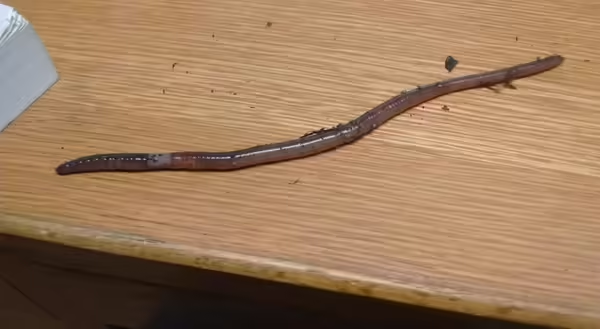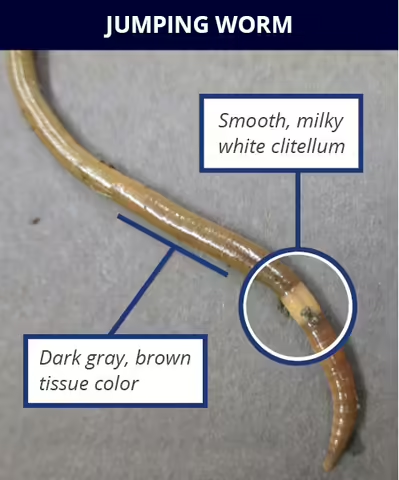
Originally posted April 15, 2021
Jumping worms (Amynthas spp) are an invasive earthworm probably brought into the country as fishing bait. They go by many names, such as crazy worms, Alabama jumpers, or snake worms. These worms are known to change the soil structure, deplete available nutrients, damage plant roots, and alter water-holding capacity of the soil. This is especially a concern in our forests, where organic matter is limited. It is important to stop the spread of jumping worms.
Appearance
These jumping worms are 4 to 8 inches long. They have a dark, metallic body that is darker on top than the bottom. A characteristic smooth milky, white band called the clitellum completely encircles the worm's body, unlike other earthworms with a pink, raised band. When handled, these worms will "jump" and thrash wildly. They move quickly in a snakelike manner and can shed their tails when threatened.
What to look for
Jumping worms are found in leaf litter and the top couple of inches of soil. Start looking for them in mid to late summer. Soil that looks like coffee grounds is a sign that jumping worms are present. One way to determine whether jumping worms are present is a mustard pour.
Mix a gallon of water with 1/3 cup of ground yellow mustard seed. Pour the mixture slowly onto the soil. This will drive the worms to the surface and does not harm plants.
Hardiness
Adults jumping worms cannot survive the cold winters of Central Illinois. However, the very small, dark egg casings persist through the winter. Jumping worms are parthenogenic, which means that a single jumping worm can reproduce by creating viable egg casings.
Damage
Jumping worms are voracious eaters, which causes them to grow twice as fast as other earthworms. This feeding changes the soil structure, altering the soil's water holding capacity and depletes the amount of nutrients available to plants. They also damage roots severely, causing weaker plants that are more susceptible to pests, drought, and disease.
Management
There are currently no viable control measures for jumping worms. Removing adult jumping worms to decrease the number of egg casings produced is the best control available at this time. Adults placed in plastic bags and left in the sun die quickly. Dispose of the bag in the trash.
Prevention is the key
The good news is that there are measures each of us can take to stop the spread.
- Thoroughly clean tools, shoes, and vehicles when moving from one site to another.
- Only purchase compost, mulch, or other organic matter that has been heated to appropriate temperatures and duration to reduce the spread of pathogens, insects, and weeds. Jumping worm egg casings do not survive temperatures over 104°F
- Follow Plant Sharing Best Practices
- Do Not buy jumping worms for bait, vermicomposting, or gardens.
Learn more about Illinois invasive species.
Invasive Species Update - Jumping Worms Fact Sheet
MEET THE AUTHOR
Nicole Flowers-Kimmerle is a Agriculture and Natural Resources (Horticulture) Educator for Fulton, Mason, Peoria and Tazewell counties. She completed a bachelors of science degree in crop science at the University of Illinois, and a master’s of science degree in agronomy with an emphasis in weed science at the University of Wisconsin-Madison. She has also worked at Montana State University as a research associate where she worked on weed control in sugar beets and barley. She taught high school chemistry and other science classes where she was able to teach students in both the school garden and greenhouse. She works with both the Extension Master Gardeners and Extension Master Naturalists.
ABOUT THE BLOG
ILRiverHort is a blog that helps people connect to nature and grow.
